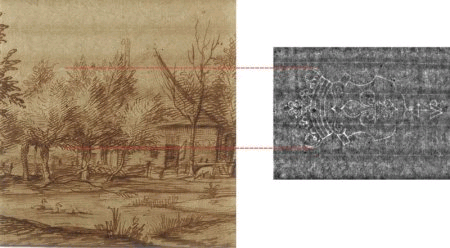When you hold an old print or drawing in front of a light source, you can often discern an image or pattern within the paper itself – a watermark. They play an important role in identifying fakes and dating old master prints. Sometimes the writing or drawing is so dense that it renders it difficult to identify the watermark under normal light. Now a scientific team in Germany has developed a new method for identifying even poorly discernible watermarks.
The physicist Peter Meinlschmidt at the Fraunhofer-Institute for Wood Research in Germany developed a quite simple, but effective thermographic method to make watermarks clearly visible. He uses the fact that printed ink is transparent under thermal radiation. A thermal source is placed behind the drawing or print; a digital camera which is sensitive to thermal radiation shows the watermark density differences in the paper. As an example, under “normal”, visible light, the watermark in the drawing by Jan Lieven is barely visible (left). A thermal infrared picture of the same drawing shows clearly a crown watermark (right).

Pictures from http://www.wki.fraunhofer.de/projekte/wki-pmt-2.html
Link:
Original oder Fälschung? (in German)

Dr. Meinlschmidt. Fascinating technique. I have an old master drawing whose partial watermark has puzzled me for years, Is there anyone in Chicago who uses your thermal photographic process who might help me? Best of luck. Robert Foley
Hello. You might contact him directly at http://www.fraunhofer.de/EN/press/pi/2007/07/Mediendienst72007Thema4.jsp (“send an e-mail”).
The method being quite simple, you might even try it by yourself. All what you need is a thermal source and a thermal infrared camera (a quick Google search lists http://www.x26.com among many others).
Old Print. Thank you for the advice. Before I bother the good Doctor I’m going to try to rent a digital camera inasmuch as they are quite expensive to purchase for my particlar purpose. I’ll keep you posted. Again, thanks. Robert Foley
Can you tell me if you know of any way to check the age of a print. I have two Durer prints and no idea of their age or value. I haven’t a clue who to bring them to or if there is a way I can tell.
I’m in the Atlanta, Georgia area.
Thanks!
Hello
I am trying to determine if any etchings I have are real or even old.
Is there a source or general information on how the paper should look.
If its from the 1700, 1800, 1900 ?
Thanks for any comments
An excellent overview over determining the age of prints can be found in:
Carlo James, Caroline Corrigan, Marie Christine Enshaian, Marie Rose Greca: Old Master Prints and Drawings. A Guide to Preservation and Conservation. Amsterdam University Press, 1997.
There is a whole chapter on Paper (p. 37-59), describing the external structure of paper at different ages, the laid lines, mould ribs and watermarks. Any print/art dealer can assist you in determining the age of your prints, auction houses do age assessments as well.
In general, a very smooth and shiny surface, perfect edges and thin paper point to a rather recent fabrication (20th/late 19th century); rather thick, visibly aged laid paper/parchment with visible laid lines (hold it towards the light) and a watermark are signs of an earlier fabrication. Those are really just general rules, there are old master prints on perfectly conserved paper from the 18th century.
Carbon dating techniques may determine the age of parchment (of organical origin, see here). Using this method, the age of the famous “Vinland map” (world first New World map) was determined in 2002 (see here).
This is a nice topic for a follow up post… stay tuned.